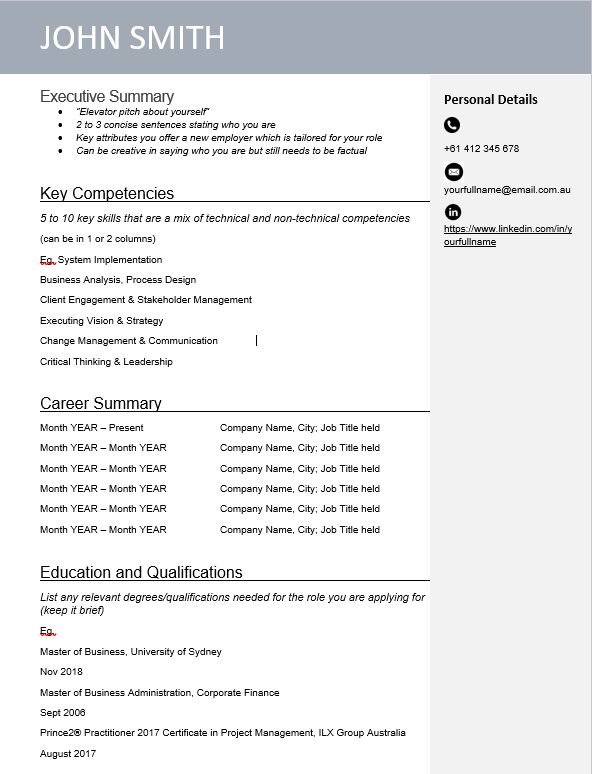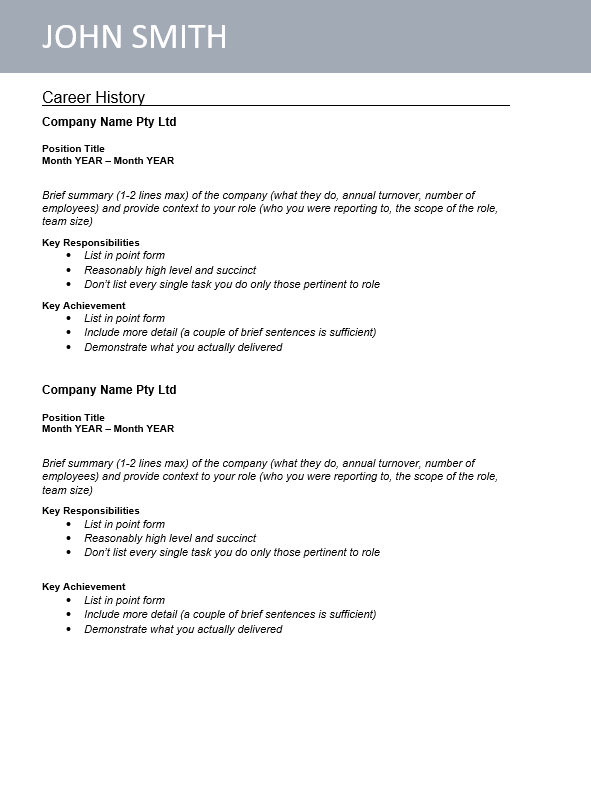With over 25 years in recruitment, I have looked at literally thousands of resumes and I definitely know what works! One part of the job that I truly love is assisting professionals to create a powerful resume. So how do you write a resume? It is an art (and it can be time-consuming) but with my detailed resume writing guide below, you too can write a powerful executive resume.
Purpose
The purpose of your resume is to get you an interview – it doesn’t actually get you the job. Your resume should be a succinct overview of your career history with enough information to demonstrate your key competencies and achievements – you don’t need every bit of detail in here. It is in some respects your own “Professional Marketing Document” so it should represent you accurately and professionally. Your resume needs to be factual, objective, well laid out and easy to read – this is not the place to be highly creative.
Format
Use simple formatting, a contemporary font large enough to be easily read. Utilise bullet points, plenty of white space, and bold the headings. Avoid making it too “fancy” with fonts and layouts that are difficult to read and print. Although a hard copy is often printed out for an interview, these days most resumes are initially read on a screen (or phone) so it needs to present well for both. Ensure your name and contact details (phone, email, LinkedIn profile link) are at the top of the front page – you don’t need to include any other personal information. I recommend the resume being between 3 and 5 pages (this is a bit longer than some people usually recommend but executives have more detail to outline).
Front Page
This is the most critical page. It ensures that the rest of the resume will even be read! Sometimes a Recruiter or Hiring Manager will make a decision to interview just based on the front page because they can readily see the candidate has the right background, qualifications and experience for the role.
It should include:
* Opening statement or executive summary: In paragraph form, write 2 or 3 concise sentences stating who you are and the key attributes you offer a new employer which is tailored for the type of role you are seeking. You can be a little bit creative, this is you saying who you are, but it still needs to be factual. It’s your “elevator pitch” that you can use anytime someone says “Tell me about yourself.”
* Key Competencies: In point form – list between 5 and 10 points in either one or two columns. These need to be factual, tailored to the level of your role and a mix of technical and non-technical competencies (e.g. project management, managing P&L, people leadership, executing vision and strategy).
* Career Summary: If you have had a reasonably linear career progressing steadily to more senior roles and working for well-known brands then, absolutely put this on the front page. If your career has been more “checkered” and for some reason, there have been lots of roles, or you had lots of breaks, then sometimes you are better to leave this off and move straight into the career history.
Don’t make the Career Summary too long – it’s better to just have the last 10 years and then list your earlier roles at the end of the Career History.
* Education and Qualifications: Often it is recommended that these are put at the end and sometimes that is more appropriate, but if you have 1 or more degrees and a couple of professional qualifications relevant to the role you are applying for then they are better on the front page. For example, a Hiring Manager probably wants to see that a Program Manager has a technology degree plus a business degree, and the relevant professional qualifications. Keep the education brief though, and if there are lots of relevant professional development courses, then put your degree on the front page and the rest at the end.
Career History
List in reverse chronological order and provide progressively less detail on each role. It is generally your last five years or so that is most relevant for your next role, although you need to put some detail for roles in the last ten years or so. Make sure you edit your resume each time you update roles to keep it relevant and drop off some of the detail on the earlier roles.
* Company Name, Position Title and Dates (month and year) should be in bold. I usually suggest putting a very brief (one or two lines) summary of the company, unless you have spent your whole career in a well-known organisation.
* The Context of the role should be summarised in a couple of lines, for example, “Company X was undergoing considerable transformation and I was hired to build a new centralised transformation function.” State who you were reporting to, the scope of the role and your team size.
* Key Responsibilities should be listed in point form – these should be reasonably high level and brief, don’t list every task in your job description.
* Key Achievements – again in point form but you can put a little more detail, sometimes a couple of brief sentences, in the achievements to demonstrate what you actually delivered.
Do this for each role – although once past that 10-year point just a line or two overviewing either responsibilities or achievements on each role is probably sufficient. You really should list all your roles, unless it is very short term and some time ago. If you have done a lot of contracting then you may group contracts or list only the significant ones. However, don’t lie on your resume – these days many organisations outsource both background and qualification checking so your discrepancies will be found out.
Technology experience
Unless you are a technology professional you don’t need to go into a lot of detail. These days it is more or less assumed you are going to have a decent level of expertise in your tools of the trade. If you feel it is necessary then put it at the back.
Cover letter
I like them and I read them, while others don’t. If the application requires one, or you feel it’s important to include one, then you must tailor it to the actual role you are applying for highlighting your most relevant skills and experience. However, like the resume, these need to be brief, to the point and factual. Limit to 1 page and use bullet points so they are easy to read.
LinkedIn Profile
Ensure your Linkedin Profile is also updated and correlates with your resume, as this is also often checked at the same time. You can make this profile much briefer noting just years of employment (not including the months) and a few bullet points with each role outlining your key responsibilities or key achievements – whichever is most powerful. These days I think it is a good idea to have a short sharp headline attached to your name, for example:
Transformation Manager / Agile & Lean Thinking / Data Literate / Major Program Delivery
You can use the executive summary and key expertise from your resume for the LinkedIn profile summary. People will also look at who you are connected to, who you follow and who is recommending you – ensure these are relevant to the roles you are seeking. You need a professional headshot as your profile photo – no holiday or family shots please. Click on this link for further information on Creating your Linkedin profile.
Finally … CHECK
Check, spell check and then check again! Then have someone else proofread as well! You don’t want any spelling or grammatical errors in this document.
Do you need help with writing a powerful Executive Resume?
Our Career Advisory experts have over 30 years of experience in crafting the perfect resume for our clients. Reach out for a complimentary resume template to build a powerful executive resume and have a chat about our comprehensive Career Optimiser program.
CLICK HERE FOR FURTHER INFORMATION ON OUR COMPREHENSIVE CAREER OPTIMISER PROGRAM
![how to write a powerful resume -[axr] Recruitment & Search](https://cdn-01.cms-ap-v2i.applyflow.com/axr/wp-content/uploads/2021/09/how-to-write-a-powerful-resume.jpg)


